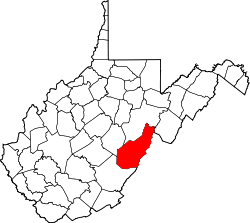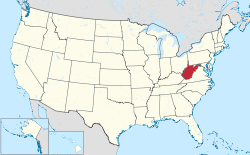History
When Andrew Lewis, early American pioneer, surveyor, and soldier from Virginia, came to survey one of the land grants for the Greenbrier Company in 1751, he found Jacob Marlin and Stephen Sewell living where Marlinton later developed. They had come from Frederick, Maryland, in 1749 and are considered to be the first European settlers in this region of Virginia. They built their original cabin where Marlin Run met Knapp's Creek. Lewis had found Sewell living in a large hollow sycamore tree near the cabin. This area is now between Eighth and Ninth avenues and Eighth and Ninth streets of Marlinton.
This area was reserved by the nations of the Iroquois Confederacy as a hunting ground, by right of their conquest of tribes that had been in the area. These American Indians resisted European settlement in the lands they had taken. A treaty of 1758 by Great Britain confirmed the land west of the Allegheny Mountains to the Indians and forbade his Majesty's subjects from settling or hunting here.
But the British settlers continued to move into the Indian hunting grounds, making them a target for many raids and massacres. After the Revolution, the Indians migrated west, and the settlers' land claims were made regular.
During the Civil War Pocahontas County voted to secede from the United States by a vote of 360 to 13 and supported the state government in Richmond. [5] The county contained 907 men of military age (15–50 years old) and provided nearly 700 men to the Confederate army and levied $15,000 for armaments. [6] Farming and harvesting crops soon became difficult due to enlistments, and many of the county's 252 slaves fled during Union troop movements through the county. Some Unionist refugees who had fled to Upshur County enlisted in the 10th West Virginia Infantry Regiment. The battles of Cheat Mountain and Camp Allegheny took place in the county in 1861, and in 1863 the battle of Droop Mountain occurred, resulting in a Union victory.
A government loyal to the United States was established in Wheeling called the Restored Government of Virginia. Under its guidance a bill was introduced to the United States Congress to create a new state from 48 counties of western Virginia to be called West Virginia. While many of these counties were generally loyal to the U.S., many were not but were taken for territorial reasons. The new state was officially recognized on June 20, 1863.
Pocahontas County was added to the new state of West Virginia without the input of the citizens. The new state government in Wheeling reorganized the county militia as a Unionist force. After the war most of the voters in the county were disfranchised due to their support of Richmond and the Confederacy, and full voting rights were not restored until 1871. [7]
The new state government divided the counties into civil townships, with the intention of encouraging local government. This proved impractical in the heavily rural state, and in 1872 the townships were converted into magisterial districts. [8] Pocahontas County was initially divided into four townships, each of which was given a patriotic name: Grant, Lincoln, Meade, and Union. They became magisterial districts in 1872, and all four were renamed the following year: Grant District, originally named for Union General Ulysses S. Grant, became Huntersville District; Lincoln, named after the President, became Edray; Meade, named for General George Meade, became Greenbank, and Union District became Academy. In the 1890s, Academy District was renamed again, becoming Little Levels. [9]
The railroads came late to Pocahontas County, as building rails over the mountains was a difficult and expensive project. It was not until 1899 that construction began but after that, the task moved with startling speed. The 1900 census of the county indicates that many European immigrants came to the region as workers on building the railroads through this area.
Commercial timbering quickly began upon completion of the railroads, including a large mill owned by the West Virginia Pulp & Paper Company (now MeadWestvaco) at Cass. By the end of 1920, dozens of small railroading towns dotted the landscape along the Chesapeake & Ohio Railway line. [10]
Demographics
Historical population| Census | Pop. | Note | %± |
|---|
| 1830 | 2,542 | | — |
|---|
| 1840 | 2,922 | | 14.9% |
|---|
| 1850 | 3,598 | | 23.1% |
|---|
| 1860 | 3,958 | | 10.0% |
|---|
| 1870 | 4,069 | | 2.8% |
|---|
| 1880 | 5,561 | | 36.7% |
|---|
| 1890 | 6,814 | | 22.5% |
|---|
| 1900 | 8,570 | | 25.8% |
|---|
| 1910 | 14,740 | | 72.0% |
|---|
| 1920 | 15,002 | | 1.8% |
|---|
| 1930 | 14,555 | | −3.0% |
|---|
| 1940 | 13,906 | | −4.5% |
|---|
| 1950 | 12,480 | | −10.3% |
|---|
| 1960 | 10,136 | | −18.8% |
|---|
| 1970 | 8,870 | | −12.5% |
|---|
| 1980 | 9,919 | | 11.8% |
|---|
| 1990 | 9,008 | | −9.2% |
|---|
| 2000 | 9,131 | | 1.4% |
|---|
| 2010 | 8,719 | | −4.5% |
|---|
| 2020 | 7,869 | | −9.7% |
|---|
| 2021 (est.) | 7,841 | [14] | −0.4% |
|---|
|
2000 census
As of the census of 2000, there were 9,131 people, 3,835 households, and 527 families living in the county. The population density was 10 people per square mile (3.9 people/km2). There were 7,594 housing units at an average density of 8 units per square mile (3.1 units/km2). The racial makeup of the county was 98.38% White, 0.78% Black or African American, 0.07% Native American, 0.14% Asian, 0.05% from other races, and 0.58% from two or more races. 0.43% of the population were Hispanic or Latino of any race.
There were 3,835 households, out of which 25.80% had children under the age of 18 living with them, 53.90% were married couples living together, 7.90% had a female householder with no husband present, and 34.10% were non-families. 29.60% of all households were made up of individuals, and 14.40% had someone living alone who was 65 years of age or older. The average household size was 2.30 and the average family size was 2.83.
In the county, the population was spread out, with 20.90% under the age of 18, 7.00% from 18 to 24, 27.50% from 25 to 44, 27.40% from 45 to 64, and 17.30% who were 65 years of age or older. The median age was 42 years. For every 100 females there were 106.20 males. For every 100 females age 18 and over, there were 103.60 males.
The median income for a household in the county was $26,401, and the median income for a family was $32,511. Males had a median income of $26,173 versus $16,780 for females. The per capita income for the county was $14,384. About 12.70% of families and 17.10% of individuals were below the poverty line, including 20.20% of those under age 18 and 14.60% of those age 65 or over.
2010 census
As of the 2010 United States census, there were 8,719 people, 3,758 households, and 2,373 families living in the county. [19] The population density was 9.3 inhabitants per square mile (3.6/km2). There were 8,847 housing units at an average density of 9.4 units per square mile (3.6 units/km2). [20] The racial makeup of the county was 97.8% white, 0.7% black or African American, 0.2% American Indian, 0.2% from other races, and 1.0% from two or more races. Those of Hispanic or Latino origin made up 0.8% of the population. [19] In terms of ancestry, 23.0% were German, 20.1% were Irish, 12.7% were English, 9.9% were American, 5.2% were Scottish, and 5.1% were Dutch. [21]
Of the 3,758 households, 24.1% had children under the age of 18 living with them, 49.1% were married couples living together, 9.1% had a female householder with no husband present, 36.9% were non-families, and 31.3% of all households were made up of individuals. The average household size was 2.24 and the average family size was 2.75. The median age was 47.1 years. [19]
The median income for a household in the county was $32,161 and the median income for a family was $40,906. Males had a median income of $32,411 versus $25,321 for females. The per capita income for the county was $19,763. About 11.8% of families and 15.3% of the population were below the poverty line, including 20.6% of those under age 18 and 11.7% of those age 65 or over. [22]
2020 census
As of the 2020 census, there were 7,869 people and 2,912 households residing in the county. There were 6,795 housing units in Pocahontas. The racial makeup of the county was 95.3% White, 0.7% African American, 0.1% Asian, 0.3% Native American, 0.5% from other races, and 3% from two or more races. Hispanics or Latinos of any race were 1.4% of the population.
Of the 2,912 households, 47.1% were married couples living together, 24.5% had a male householder with no spouse present, 22.4% had a female householder with no spouse present. The average household and family size was 3.48. The median age in the county was 49.6 years with 17.5% of the population under 18. The median income for a household was $37,225 and the poverty rate was 17.5%. [23]








